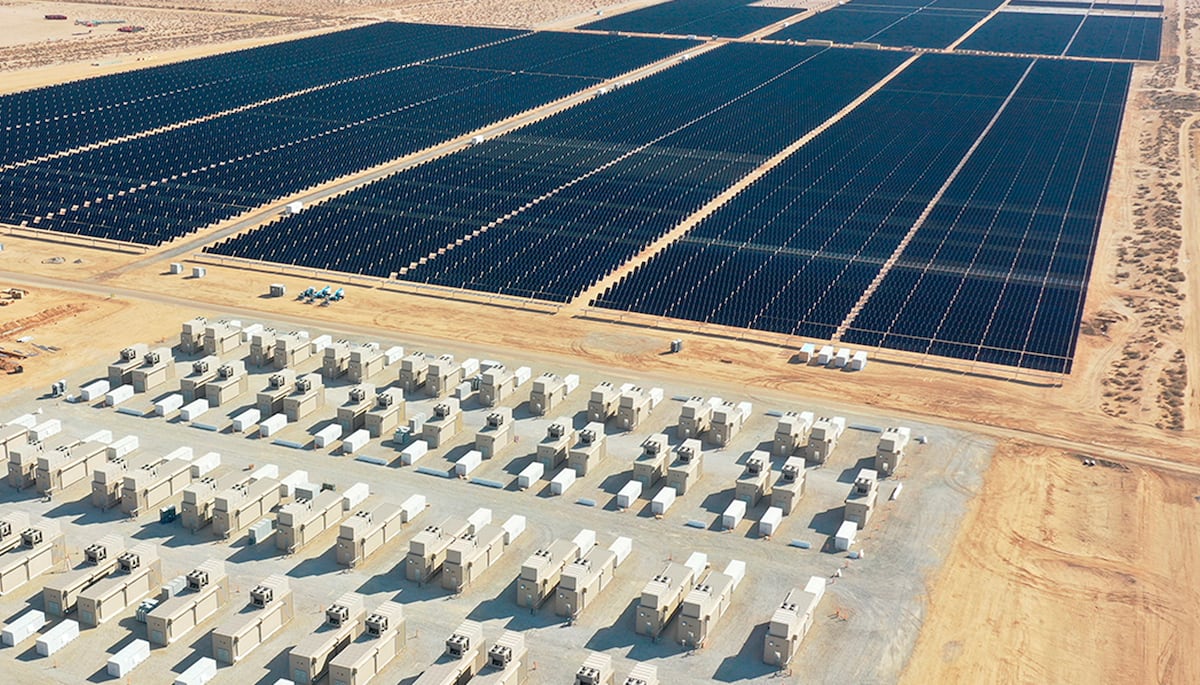At the gates of the Mojave Desert, a vast black ocean of more than 1.9 million solar panels stretches out. This gigafactory began operations earlier this year and is one of the latest additions to the power grid in California, the state that leads the US in the race for clean energy. Operated by the Minnesota company Mortenson, the plant has a storage capacity of 3,280 megawatts in 120,000 installed batteries, making it the only one in the country with this level of autonomy, which is crucial to achieving the ambitious goal set by local authorities for 2045, when the state will rely 100% on renewable energy.
California reached an important milestone in the fight against climate change at the end of April. At the time, Governor Gavin Newsom announced that the region had exceeded the 10,000 megawatt mark in photovoltaic storage capacity for the first time, which is enough to meet 20 percent of demand. “In just five years, California has increased its battery storage capacity more than tenfold,” said Newsom. When he came to power in 2019, the state had 770 megawatts of storage capacity. To meet the goals set for 2045, California must build a 52,000 megawatt storage network.
The progress in the most populous state in the U.S. is staggering. Mark Rothleder, vice president of independent grid operator California ISO (CAISO), said earlier this year that another 1,134 megawatts will be added in the first eight months of 2024. This is growth that comes on top of last year’s jump. “In 2023 alone, the ISO successfully added 5,660 megawatts of new capacity to the grid,” Rothleder said at a conference in San Diego.
Strengthen
Rothleder also highlighted the growing number of lithium batteries as the system’s greatest strength: “It’s an impressive Californian success story because, despite occasional glitches, the four-hour batteries have worked very well and we’ve been able to make that stored energy available for peak evening use during the day when it’s needed most,” he said. Currently, the high cost of batteries is one of the main obstacles to wider adoption of this technology. Experts say that as prices fall, battery life could be extended to eight to 10 hours.
The mild climate of 2023, the wettest year in a region known for persistent drought and numerous wildfires, was key to advancing the renewable energy grid. Last summer was the first of four in which the regulator did not issue a public alert urging people to turn off appliances and conserve energy to ensure demand does not exceed supply. In the previous three years, 29 such alerts were issued.
Spring 2024 also helped California reach more clean energy milestones. Mild temperatures kept demand low as people used their air conditioners less. After sunset, energy stored in batteries was used and gas was injected into the system to meet demand. Renewable energy production was enough to power the grid on 40 of 48 days this spring, compared to seven days for all of last year.
Lithium batteries appear to be undercutting fossil fuel use. Gas makes up 40% of California’s electricity grid, but in April its use was at its lowest level in seven years. “The data clearly shows that batteries are displacing natural gas while solar generation in CAISO is ramping up and down daily,” said an analysis by Grid Status, a firm specializing in energy issues.
In April 2021, 2022 and 2023, natural gas was king on the grid. When solar ran out, CAISO added between 9,000 and 10,000 megawatts of gas to the grid. But last April, it added just 5,000 megawatts. On April 30, a fleet of batteries came online around 6 p.m. and was active until midnight. Around 8 p.m., during peak demand, lithium contributed 7,000 megawatts, equal to the megawatts generated by gas at that time of day.
Arizona and Georgia have followed California’s example, but Texas, the other major US giant in the industry, is hot on its heels. At the end of April, batteries provided 4% of the electricity on the grid, enough to power several million homes. Batteries are beginning to be seen as an alternative to a system that is heavily dependent on gas and coal. The grid is facing increasing climatic challenges, such as very low temperatures in winter and extreme heat in summer.
Register for our weekly newsletter to get more English-language coverage from EL PAÍS USA Edition

